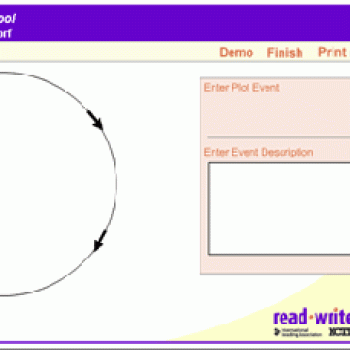Unwinding A Circular Plot: Prediction Strategies in Reading and Writing

- Preview |
- Standards |
- Resources & Preparation |
- Instructional Plan |
- Related Resources |
- Comments
Overview
Circular stories follow a “round” pattern—they begin and end in the same way. Like the cycle of seasons or the life cycle, circular stories follow a predictable series of events that returns to the starting point. Building on students' existing knowledge of plot structure and of cycles in other content areas, this lesson invites students to use a circle plot graphic organizer to explore the structure of this type of story. The cyclical nature of the stories is an excellent match for discussion of prediction and sequencing skills. After exploring the features of circular plot stories and reading a model story, such as Laura Joffe Numeroff's If You Give a Mouse a Cookie, students write their own stories individually or in small groups.
Featured Resources
Circular or Cyclical Books: This sheet provides a list of circular stories that can be used as models before students write their own circular plot stories.
Circle Plot Story Rubric: Teachers can use this rubric to evaluate the plot, creativity, sentence structure, and conventions of students' circular stories.
Interactive Circle Plot Diagram: Using this online tool, students can label and describe the plot events of a circular story. Finished work can be printed.
From Theory to Practice
In Literary Discussion in the Elementary School, Joy Moss explains that "Since prediction is an important strategy used in the reading process, the teacher can demonstrate this strategy by stopping at significant points [in the story] and asking, What do you think will happen next? As children internalize this question, they develop an anticipatory attitude toward print, making predictions as they read or listen to a text in order to generate meaning as the story unfolds" (67).
Circular and cyclical plot stories are excellent resources for introducing student prediction strategies because of their repetitive nature. This repetition encourages students to predict events with more success. By introducing and supporting prediction strategies, teachers encourage students to "learn to construct a working interpretation of the story based on the clues they gather and to revise or refine this interpretation as they find new information in and generate new meaning from the unfolding text" (Moss, 67). Eventually, students "internalize these strategies and use them on their own to make sense of texts they listen to or read independently" (Moss, 68).
Further Reading
Common Core Standards
This resource has been aligned to the Common Core State Standards for states in which they have been adopted. If a state does not appear in the drop-down, CCSS alignments are forthcoming.
State Standards
This lesson has been aligned to standards in the following states. If a state does not appear in the drop-down, standard alignments are not currently available for that state.
NCTE/IRA National Standards for the English Language Arts
- 1. Students read a wide range of print and nonprint texts to build an understanding of texts, of themselves, and of the cultures of the United States and the world; to acquire new information; to respond to the needs and demands of society and the workplace; and for personal fulfillment. Among these texts are fiction and nonfiction, classic and contemporary works.
- 2. Students read a wide range of literature from many periods in many genres to build an understanding of the many dimensions (e.g., philosophical, ethical, aesthetic) of human experience.
- 3. Students apply a wide range of strategies to comprehend, interpret, evaluate, and appreciate texts. They draw on their prior experience, their interactions with other readers and writers, their knowledge of word meaning and of other texts, their word identification strategies, and their understanding of textual features (e.g., sound-letter correspondence, sentence structure, context, graphics).
- 8. Students use a variety of technological and information resources (e.g., libraries, databases, computer networks, video) to gather and synthesize information and to create and communicate knowledge.
- 11. Students participate as knowledgeable, reflective, creative, and critical members of a variety of literacy communities.
- 12. Students use spoken, written, and visual language to accomplish their own purposes (e.g., for learning, enjoyment, persuasion, and the exchange of information).
Materials and Technology
- Chart paper and markers
- Any circle-plot story by Laura Joffe Numeroff (e.g., If You Give a Mouse a Cookie) or another book with a circular plot
- A list of stories read by the class
Printouts
Websites
Preparation
- Select a story by Laura Joffe Numeroff (e.g., If You Give a Mouse a Cookie) or another picture book with a circular plot. See the book list for additional options.
- Test the Circle Plot Diagram student interactive on your computers to familiarize yourself with the tool and ensure that you have the Flash plug-in installed. You can download the plug-in from the technical support page.
- Use page 11 of this printable set of graphic organizers from BalancedReading.com as an alternative if computers are not available to your class.
- If desired, compile a list of stories read by the class, to be sorted into categories of linear versus circular plots. Alternately, students can brainstorm this list during the session.
- Make copies of the Circle Plot Story Rubric for students.
Student Objectives
Students will
- Read and respond to stories that rely on circular plots, comparing and contrasting their features with those of other plot structures.
- Predict alternatives or probabilities in stories based on prior knowledge and information within the texts.
- Confirm or self-correct predictions in response to stories.
- Complete graphic organizers to demonstrate comprehension of circular stories.
- Use graphic organizers as a prewriting technique.
- Write an original circular story.
Session One
- Draw a circle on a piece of chart paper. Ask, “Does anyone know what I am drawing?” Most students will see that the shape is a circle.
- Ask students to identify the characteristics of the shape. Be sure that students discuss the difference between a line and a circle and that they recognize that a circle ends at the same place it began.
- Ask students to brainstorm things that follow a circular pattern—for instance, seasons, weather phenomena, cycles of achievement and failure, the life cycle, time (which can be reinforced by the shape of an analog clock), and so forth. You might connect this discussion to units in other content areas that you’ve covered in class (e.g., to discussions of seasons in different habitats or to biological life cycles of different animals).
- Relate the circular idea to different types of stories. Some stories begin with one event and end with a different one, but others begin with one event and work their way back to the same place.
- Using a list of stories that students have read, ask students to categorize the stories based on whether the stories have linear or circular plots. Alternately, students can brainstorm this list and categorize it. Students might focus solely on stories read by the whole class or they might also include stories that they’ve read individually and shared during Book Boosts or book reports.
- Tell them that they will be hearing a circle story, a story that ends in the same place it begins.
- Read the first page of If You Give a Mouse a Cookie, or the picture book that you’ve chosen. Ask, “Where does this story begin?” Have students predict where it will end.
- Continue with the story, pausing to ask students to predict the events that will occur in the story. For example, what will happen when the mouse asks to hear a story?
- Briefly discuss why this story is called a circular story. Point out that each event leads to the next until the story returns to the starting point—the beginning and ending match. Connect this characteristic to the features of a circle that students established at the beginning of the activity.
- Ask students what they notice about the words that are used in the story. To help students recognize the patterns, you can write some sentences from the story on chart paper or the board. Students should notice that the stories use many of the same words and sentence structures, making only small changes as they move toward the ending.
- If the story you’ve shared has a clear sentence pattern, as is the case in most of Numeroff’s books, you might create a fill-in-the-blank version of the story on the board or on chart paper. In the case of Numeroff’s If You Give a Mouse a Cookie, you’d write “If you give a _______ a ________, he’s going to ______________.”
- When the reading is complete, diagram the plot of their book using the Circle Plot Diagram student interactive to reinforce the relationship between the events in the story and the connection between the beginning and ending points.
- If students need more practice analyzing circular plot stories, share additional books from the book list with the whole class, or divide students into small groups and ask them to read and plot the story using the Circle Plot Diagram student interactive.
Session Two
- Once students understand the structure and characteristics of circular stories, explain that you are going to write your own circular plot stories.
- Ask students to brainstorm a variety of possible topics for their stories.
- Choose one of the topics from the list for a circular story that you’ll write collaboratively. Save the list for students to consult later in the lesson when they write their own stories.
- Demonstrate how to use the Circle Plot Diagram student interactive as a prewriting tool by choosing the series of events for the class story and placing them on the diagram.
- Remind students of the story’s sentence structure. Be sure to explain options the sentence pattern: students can use “a,” “an,” or “the” as well as change the pronoun to fit the situation (“he,” “she,” “it,” or “they”).
- Once the class has created a story as a group, have students choose an item from the list or another topic and use the Circle Plot Diagram student interactive to plot out the series of events for their own stories, individually or in small groups.
- If student’s work will be formally evaluated, share the Circle Plot Story Rubric and discuss the criteria.
- Students print out their diagrams and use the graphic organizer to write their own stories.
- As students work, circulate through the room, answering any questions and monitoring students’ progress. If necessary, students can complete their stories at home or during later sessions.
Extensions
- After the students have explored simple circular stories, share a novel with a cyclical structure, such as The Birchbark House by Louise Erdrich (Hyperion Press, 2002), either in read-aloud or as a class reading.
- After your exploration of circle plot stories, explore Native American storytelling with the resources on the Public Broadcasting Service (PBS) Circle of Stories Website. The site features documentary film, photography, artwork, and music that can help you introduce and explore the importance of circles and cycles in Native American stories.
Student Assessment / Reflections
Evaluate students on their ability to create an accurate graphic organizer and predict events in the circular stories they read and hear. They should be able to demonstrate the cyclical nature of these stories using the Circle Plot Diagram student interactive.
Examine the circular plot stories that students write for evidence that they have applied their understanding of the plot structure. If they understand the characteristics of a circle story, their stories will begin and end in the same place and will have logical connections between events. More advanced writers will adopt sentence structures that rely on matching or similar words, as demonstrated in the stories that they have read and heard. For more formal assessment, use the Circle Plot Story Rubric.

Add new comment